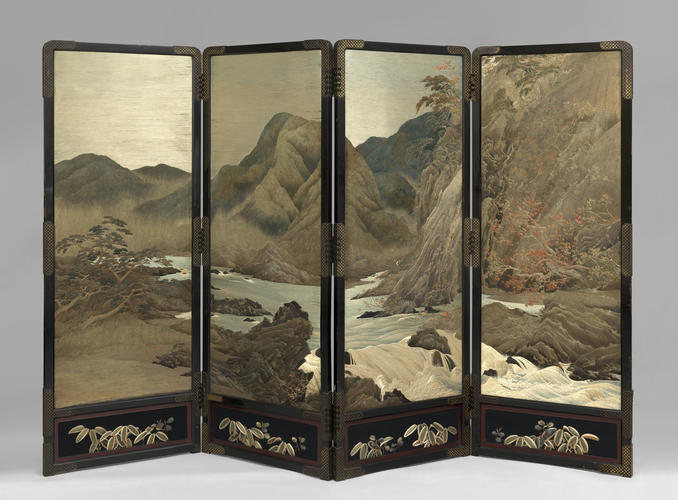-
1 of 253523 objects
Embroidered folding screen c.1880-97
Silk embroidery with silk thread, calamander wood frame, metal | 177.0 x 66.5 x 13.5 cm (each leaf) | RCIN 79563

Kyoto [Japan]
Embroidered folding screen c.1880-97


-
Among the gifts received by Queen Victoria for her Diamond Jubilee in 1897 was this four-leaf folding screen sent by the Emperor Meiji. On 24 June, two days after the official Jubilee celebration in London, which the queen described as a ‘never to be forgotten day’, Prince Arisugawa Takehito was a guest at lunch with the queen at Windsor Castle. Later that afternoon he presented officers of the Japanese fleet who had travelled to Britain to take part in the Jubilee naval review.
The arrival of the screen is not recorded in Queen Victoria’s Journal but it was among the Jubilee gifts exhibited in the North Gallery of the Imperial Institute later that year. According to the Illustrated London News, ‘Of Eastern screens there are beautiful examples, particularly noteworthy being one with silk panels representing wild mountain scenery where a foaming torrent is rendered with exquisite power and fidelity. This treasure is the gift of the Emperor of Japan.’
The Japanese imperial family acquired textiles from the Kyoto firms of Nishimura, Iida and Kawashima from the 1880s, both to furnish the new Imperial Palace in Tokyo, completed in 1889, and to present as gifts to foreign sovereigns and rulers to mark important occasions and foster relationships. The gift of this embroidered folding screen is recorded in Meiji tennō ki, The Record of the Emperor Meiji, where it is described as an ‘embroidered Arashiyama scene byōbu’.
The precise maker is unknown, but is almost certainly one of the three most important firms mentioned above. The embroidery is exceptionally fine – the subtle delicacy of the muted colours revealing the majestic landscape of Arashiyama near Kyoto, with its mountains, foaming river, rocks and trees. Many traditional Japanese stitches are used, including foundation layers (hira-nui) and long and short stitch (sashi-nui). Cotton wadding creates a relief effect, particularly on the rocks and trees in the foreground. Below each of the four panels of the screen is a smaller rectangular panel embroidered on a black ground in silk, with leaves in green and cream and red berries. The reverse of the screen is of silk painted with a scene of ducks in flight.
Text adapted from Japan: Courts and Culture (2020)Provenance
Sent to Queen Victoria by the Emperor Meiji for her Diamond Jubilee, 1897
-
Creator(s)
(nationality)(nationality)Acquirer(s)
-
Medium and techniques
Silk embroidery with silk thread, calamander wood frame, metal
Measurements
177.0 x 66.5 x 13.5 cm (each leaf)
Place of Production
Kyoto [Japan]